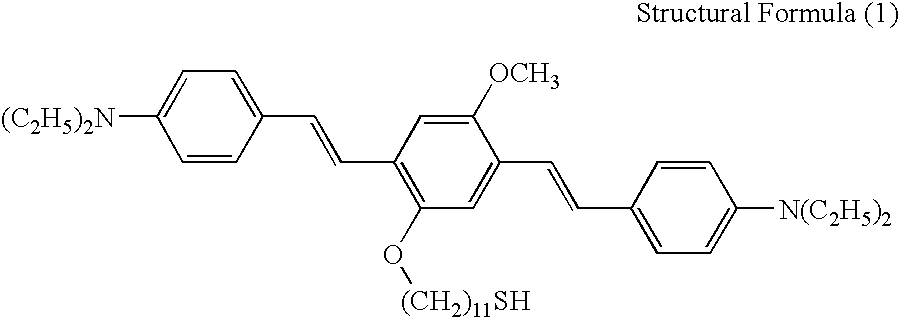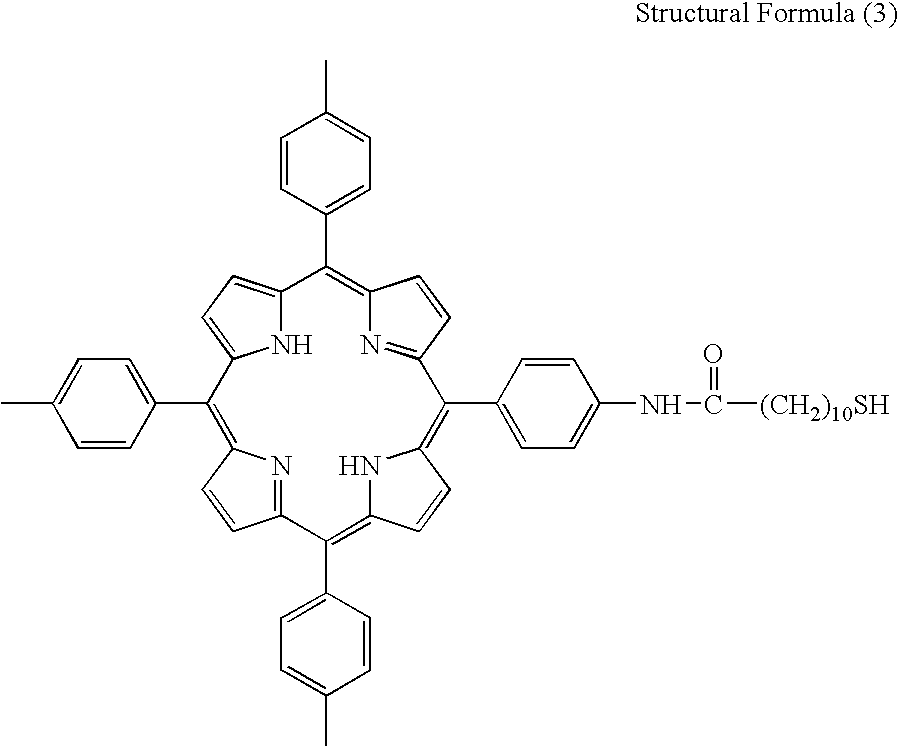Photosensitized composite material, three-dimensional memory material and recording medium, optical power limiting material and element, and photocuring material and stereolithography system, and fluorescent material for multiphoton fluorescence microscope and multiphoton fluorescence microscope
- Summary
- Abstract
- Description
- Claims
- Application Information
AI Technical Summary
Benefits of technology
Problems solved by technology
Method used
Image
Examples
synthesis example 1
of Gold Nanorod
[0160]First, 70 mL of 0.18 mol / L cetyltrimethylammonium bromide aqueous solution, 0.36 mL of cyclohexane, 1 mL of acetone, and 1.2 mL of 0.1 mol / L silver nitrate aqueous solution were mixed and stirred. After 0.3 mL of 0.24 mol / L chloroauric acid aqueous solution was added, 0.3 mL of 0.1 mol / L ascorbic acid aqueous solution was added, and it was confirmed that color of the chloroauric acid became extinct. Thereafter, this solution was transferred to a dish and irradiated with an ultraviolet ray having a wavelength of 254 nm, for 20 minutes by a low-pressure mercury lamp. Accordingly, a gold nanorod dispersion solution having an absorption peak wavelength of approximately 800 nm was obtained. This dispersion solution was set in a centrifuge to separate and sediment the gold nanorod component. This supernatant was removed and water was added to the dispersion solution. Centrifugal separation was repeated several times to remove an excessive dispersant of cetyltrimethyla...
synthesis example 2
of Gold Nanorod
[0161]First, 70 mL of 0.18 mol / L cetyltrimethylammonium bromide aqueous solution, 0.36 mL of cyclohexane, 1 mL of acetone, and 1.0 mL of 0.1 mol / L silver nitrate aqueous solution were mixed and stirred. After 0.3 mL of 0.24 mol / L chloroauric acid aqueous solution was added, 0.3 mL of 0.1 mol / L ascorbic acid aqueous solution was added, and it was confirmed that color of the chloroauric acid became extinct. Thereafter, this solution was transferred to a dish and irradiated with an ultraviolet ray having a wavelength of 254 nm, for 20 minutes by a low-pressure mercury lamp. Accordingly, a gold nanorod dispersion solution having an absorption peak wavelength of approximately 760 nm was obtained. This dispersion solution was set in a centrifuge to separate and sediment the gold nanorod component. This supernatant was removed and water was added to the dispersion solution. Centrifugal separation was repeated several times to remove an excessive dispersant of cetyltrimethyla...
synthesis example 3
of Gold Nanorod
[0162]First, 70 mL of 0.18 mol / L cetyltrimethylammonium bromide aqueous solution, 0.36 mL of cyclohexane, 1 mL of acetone, and 1.5 mL of 0.1 mol / L silver nitrate aqueous solution were mixed and stirred. After 0.3 mL of 0.24 mol / L chloroauric acid aqueous solution was added, 0.3 mL of 0.1 mol / L ascorbic acid aqueous solution was added, and it was confirmed that color of the chloroauric acid became extinct. Thereafter, this solution was transferred to a dish and irradiated with an ultraviolet ray having a wavelength of 254 nm, for 20 minutes by a low-pressure mercury lamp. Accordingly, a gold nanorod dispersion solution having an absorption peak wavelength of approximately 840 nm was obtained. This dispersion solution was set in a centrifuge to separate and sediment the gold nanorod component. This supernatant was removed and water was added to the dispersion solution. Centrifugal separation was repeated several times to remove an excessive dispersant of cetyltrimethyla...
PUM
 Login to View More
Login to View More Abstract
Description
Claims
Application Information
 Login to View More
Login to View More - R&D
- Intellectual Property
- Life Sciences
- Materials
- Tech Scout
- Unparalleled Data Quality
- Higher Quality Content
- 60% Fewer Hallucinations
Browse by: Latest US Patents, China's latest patents, Technical Efficacy Thesaurus, Application Domain, Technology Topic, Popular Technical Reports.
© 2025 PatSnap. All rights reserved.Legal|Privacy policy|Modern Slavery Act Transparency Statement|Sitemap|About US| Contact US: help@patsnap.com



